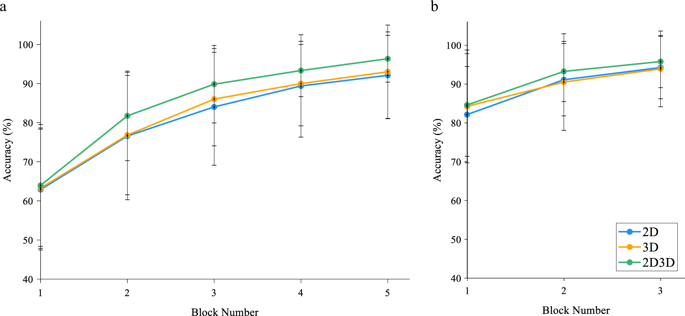npj Science of Learning ( IF 3.6 ) Pub Date : 2019-07-17 , DOI: 10.1038/s41539-019-0050-4 Sarah J. Anderson , Heather A. Jamniczky , Olave E. Krigolson , Sylvain P. Coderre , Kent G. Hecker

|
Advances in computer visualization enabling both 2D and 3D representation have generated tools to aid perception of spatial relationships and provide a new forum for instructional design. A key knowledge gap is the lack of understanding of how the brain neurobiologically processes and learns from spatially presented content, and new quantitative variables are required to address this gap. The objective of this study was to apply quantitative neural measures derived from electroencephalography (EEG) to examine stereopsis in anatomy learning by comparing mean amplitude changes in N250 (related to object recognition) and reward positivity (related to responding to feedback) event related to potential components using a reinforcement-based learning paradigm. Health sciences students (n = 61) learned to identify and localize neuroanatomical structures using 2D, 3D, or a combination of models while EEG and behavioral (accuracy) data were recorded. Participants learning using 3D models had a greater object recognition (N250 amplitude) compared to those who learned from 2D models. Based on neurological results, interleaved learning incorporating both 2D and 3D models provided an advantage in learning, retention, and transfer activities represented by decreased reward positivity amplitude. Behavioral data did not have the same sensitivity as neural data for distinguishing differences in learning with and without stereopsis in these learning activities. Measuring neural activity reveals new insights in applied settings for educators to consider when incorporating stereoscopic models in the design of learning interventions.
中文翻译:

使用脑电图量化解剖学中的二维和三维立体学习
支持2D和3D表示的计算机可视化技术的进步已经产生了有助于感知空间关系并为教学设计提供新论坛的工具。关键的知识鸿沟是缺乏对大脑神经生物学如何处理和从空间呈现的内容中学习的了解,因此需要新的定量变量来解决这一鸿沟。这项研究的目的是应用脑电图(EEG)得出的定量神经测量方法,通过比较N250的平均振幅变化(与物体识别有关)和奖励积极性(与对反馈的反应有关)来检查解剖学习中的立体视。组件使用基于增强的学习范例。卫生科学系学生(n = 61)学会了使用2D,3D或模型的组合来识别和定位神经解剖结构,同时记录了EEG和行为(准确性)数据。与从2D模型学习的参与者相比,使用3D模型学习的参与者具有更高的对象识别能力(N250振幅)。根据神经学结果,结合了2D和3D模型的交错学习在学习,保留和转移活动方面具有优势,表现为降低的报酬积极性幅度。行为数据不具有与神经数据相同的敏感性,以区分这些学习活动中有无立体视的学习差异。对神经活动的测量揭示了在应用环境中的新见解,供教育工作者在将立体模型纳入学习干预设计时考虑。











































 京公网安备 11010802027423号
京公网安备 11010802027423号